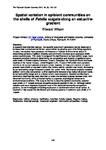Spatial variation in epibiont communities on the shells of Patella vulgata along an estuarine gradient
| dc.contributor.author | Wilson, E. | |
| dc.date.accessioned | 2021-12-24T17:15:27Z | |
| dc.date.available | 2021-12-24T17:15:27Z | |
| dc.date.issued | 2021 | |
| dc.identifier.citation |
Wilson, E. (2021) 'Spatial variation in epibiont communities on the shells of Patella vulgata along an estuarine gradient', The Plymouth Student Scientist, 14(2), pp. 140-159. | en_US |
| dc.identifier.uri | http://hdl.handle.net/10026.1/18502 | |
| dc.description.abstract |
In space limited intertidal habitats, non-specific substratum generalists can be observed to increase their survival and settlement opportunities by growing upon other living organisms. To date, few studies have assessed the influence of multiple environmental factors in determining patterns of epibiont diversity and community structure upon gastropod shells, across spatial scales. This study investigated the significance of surface salinity range, wave exposure and shell metrics in determining the composition and diversity of epibionts found upon shells of Patella vulgata (Common Limpet), throughout the Plymouth Sound and lower reaches of the Tamar Estuary, United Kingdom (UK). A total of 292 shells were sampled, identifying 26 epibiont species amongst 9 phyla. Species richness and diversity (H’) were greatest upon shells at exposed marine sites (where salinity variation was lower), decreasing as surface salinity range increased towards the Lynher River. Multivariate analysis revealed epibiont community composition to differ significantly between sites, being influenced mainly by surface salinity range and, to a lesser extent, wave exposure. Species contributing to community dissimilarities were identified to reflect the dominant species between sites, with observed community shifts attributed mainly to a species physiological tolerance to environmental conditions. This study is the first to describe epibiont community variation upon shells of P. vulgata along an estuarine-exposure gradient in the UK. Although salinity variation and wave exposure explained most of the observed community composition patterns, further investigation including exploration of additional environmental factors, is required to fully explain the distribution and diversity patterns of epibionts upon shells of P. vulgata. | en_US |
| dc.language.iso | en | en_US |
| dc.publisher | University of Plymouth | en_US |
| dc.rights | Attribution 3.0 United States | * |
| dc.rights.uri | http://creativecommons.org/licenses/by/3.0/us/ | * |
| dc.subject | Epibiont diversity, | en_US |
| dc.subject | Facillitation | en_US |
| dc.subject | Intertidal | en_US |
| dc.subject | Patella vulgata | en_US |
| dc.subject | Biogenic Habitat | en_US |
| dc.subject | Biodiversity | en_US |
| dc.subject | Intertidal ecology | en_US |
| dc.subject | Ecosystem engineer | en_US |
| dc.subject | Community composition | en_US |
| dc.subject | Ecology | en_US |
| dc.title | Spatial variation in epibiont communities on the shells of Patella vulgata along an estuarine gradient | en_US |
| dc.type | Article | en_US |
| plymouth.issue | 2 | |
| plymouth.volume | 14 | |
| plymouth.journal | The Plymouth Student Scientist |



